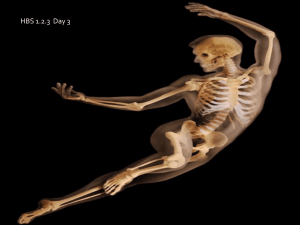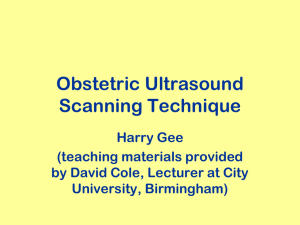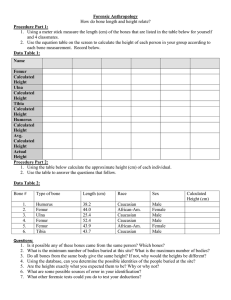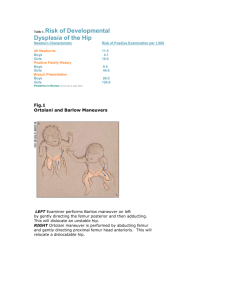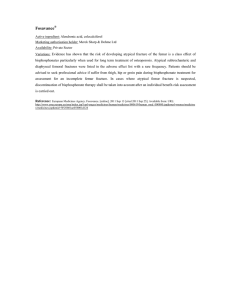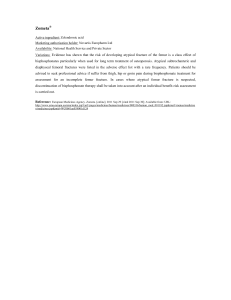Asian Journal of Medical Sciences 4(2): 94-98, 2012 ISSN: 2040-8773
advertisement
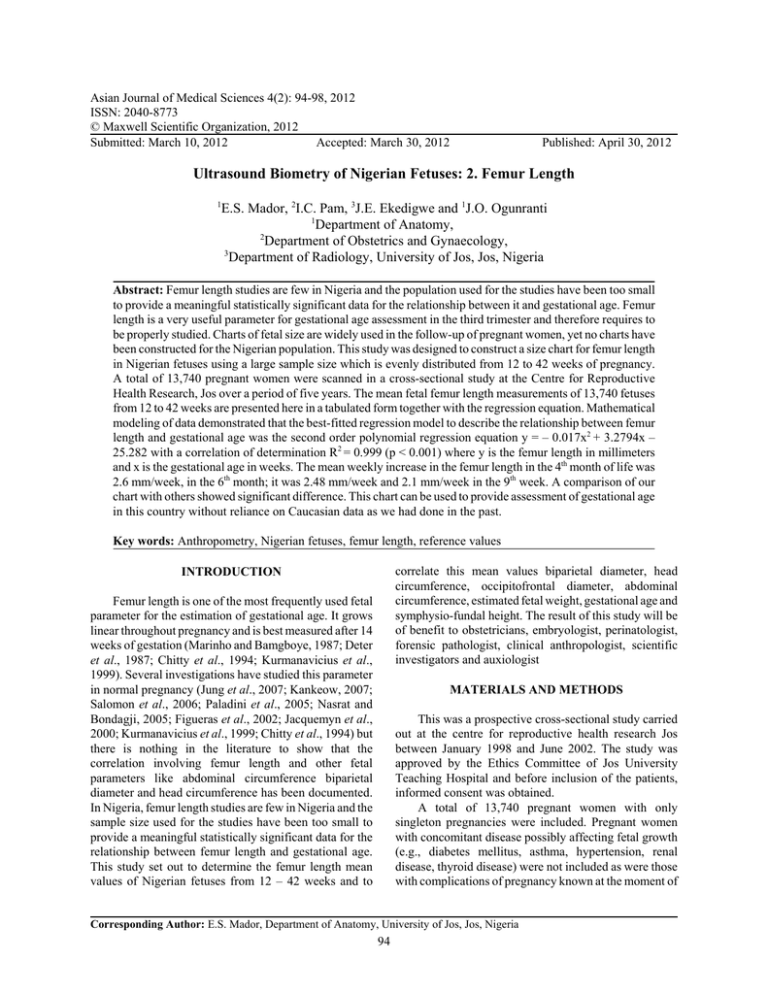
Asian Journal of Medical Sciences 4(2): 94-98, 2012 ISSN: 2040-8773 © Maxwell Scientific Organization, 2012 Submitted: March 10, 2012 Accepted: March 30, 2012 Published: April 30, 2012 Ultrasound Biometry of Nigerian Fetuses: 2. Femur Length 1 E.S. Mador, 2I.C. Pam, 3J.E. Ekedigwe and 1J.O. Ogunranti 1 Department of Anatomy, 2 Department of Obstetrics and Gynaecology, 3 Department of Radiology, University of Jos, Jos, Nigeria Abstract: Femur length studies are few in Nigeria and the population used for the studies have been too small to provide a meaningful statistically significant data for the relationship between it and gestational age. Femur length is a very useful parameter for gestational age assessment in the third trimester and therefore requires to be properly studied. Charts of fetal size are widely used in the follow-up of pregnant women, yet no charts have been constructed for the Nigerian population. This study was designed to construct a size chart for femur length in Nigerian fetuses using a large sample size which is evenly distributed from 12 to 42 weeks of pregnancy. A total of 13,740 pregnant women were scanned in a cross-sectional study at the Centre for Reproductive Health Research, Jos over a period of five years. The mean fetal femur length measurements of 13,740 fetuses from 12 to 42 weeks are presented here in a tabulated form together with the regression equation. Mathematical modeling of data demonstrated that the best-fitted regression model to describe the relationship between femur length and gestational age was the second order polynomial regression equation y = – 0.017x2 + 3.2794x – 25.282 with a correlation of determination R2 = 0.999 (p < 0.001) where y is the femur length in millimeters and x is the gestational age in weeks. The mean weekly increase in the femur length in the 4th month of life was 2.6 mm/week, in the 6th month; it was 2.48 mm/week and 2.1 mm/week in the 9th week. A comparison of our chart with others showed significant difference. This chart can be used to provide assessment of gestational age in this country without reliance on Caucasian data as we had done in the past. Key words: Anthropometry, Nigerian fetuses, femur length, reference values correlate this mean values biparietal diameter, head circumference, occipitofrontal diameter, abdominal circumference, estimated fetal weight, gestational age and symphysio-fundal height. The result of this study will be of benefit to obstetricians, embryologist, perinatologist, forensic pathologist, clinical anthropologist, scientific investigators and auxiologist INTRODUCTION Femur length is one of the most frequently used fetal parameter for the estimation of gestational age. It grows linear throughout pregnancy and is best measured after 14 weeks of gestation (Marinho and Bamgboye, 1987; Deter et al., 1987; Chitty et al., 1994; Kurmanavicius et al., 1999). Several investigations have studied this parameter in normal pregnancy (Jung et al., 2007; Kankeow, 2007; Salomon et al., 2006; Paladini et al., 2005; Nasrat and Bondagji, 2005; Figueras et al., 2002; Jacquemyn et al., 2000; Kurmanavicius et al., 1999; Chitty et al., 1994) but there is nothing in the literature to show that the correlation involving femur length and other fetal parameters like abdominal circumference biparietal diameter and head circumference has been documented. In Nigeria, femur length studies are few in Nigeria and the sample size used for the studies have been too small to provide a meaningful statistically significant data for the relationship between femur length and gestational age. This study set out to determine the femur length mean values of Nigerian fetuses from 12 – 42 weeks and to MATERIALS AND METHODS This was a prospective cross-sectional study carried out at the centre for reproductive health research Jos between January 1998 and June 2002. The study was approved by the Ethics Committee of Jos University Teaching Hospital and before inclusion of the patients, informed consent was obtained. A total of 13,740 pregnant women with only singleton pregnancies were included. Pregnant women with concomitant disease possibly affecting fetal growth (e.g., diabetes mellitus, asthma, hypertension, renal disease, thyroid disease) were not included as were those with complications of pregnancy known at the moment of Corresponding Author: E.S. Mador, Department of Anatomy, University of Jos, Jos, Nigeria 94 Asian J. Med. Sci.,4(2): 94-98, 2012 O’Brien et al. (1981). Estimated fetal weight was calculated in grams by the formulae described by Shepard (1982) as these are included in the software of most commercially available ultrasound scanners. Data were analyzed using Number Cruncher Statistical System (NCSS/PASS 2006 Dawson Edition, USA). Values of abdominal circumference at various gestational ages were expressed as mean, standard deviation, standard error of mean together with percentiles. Statistical significance was considered at 0.001. Person’s correlation and regression analysis was used to establish the relationship between femur length and gestational, symphysio-fundal height, biparietal diameter, head circumference, abdominal circumference, occipitofrontal diameter and estimated fetal weight the ultrasound scan (e.g., bleeding, pre-eclampsia). If a fetal malformation was detected during the examination the patient was excluded. Patients with a history of obstetric complications, intrauterine growth retardation or macrosomia were also excluded. The investigators did not take into account complications or diagnosis that occurred later in the pregnancy, after the ultrasound measurements were performed. Every fetus was measured and included only once so that a pure cross-sectional set of data was constructed. For each patient the gestational age was recorded, as were last menstrual period, maternal age and parity. Maternal age was calculated in completed years at the moment of the ultrasound. Symphysio-fundal height measurements were taken using a non-stretch tape measure in centimeter. Obstetric ultrasonography was carried out on the patients using Philips Real time ultrasound machine equipped with 3.5 MHz transducer and an electronic caliper system set at a velocity of 1540 m/s. Head circumference measurement was made at the fetal plane described by Campbell and Thoms (1977). Biparietal diameter measurement was made on the same frozen image for head circumference from outer to outer table of the skull (Campbell and Thoms, 1977). Abdominal circumference was made on the fetal plane described by Campbell and Wilkin (1975). Femur length measurements were made using the method described by RESULTS The distribution of mean femur length of fetuses by ultrasound gestational age grouping together with standard deviation, standard error of mean and percentiles is shown in Table 1. When mean femur length values were plotted against gestation age (Fig. 1), a positive correlation was found. Mathematical modeling of data demonstrated that the best-fitted regression model (Fig. 2)to describe the relationship between femur length Table 1: Femur length mean values, standard deviation, standard error of mean and percentiles from 12 – 42 weeks gestation Percentiles --------------------------------------------------------------------------------------------------------Gestational age (weeks) Fetus number Mean FL (mm) SD SE 3rd 5th 10th 50th 90th 95th 97th 12 to 12+6 49 12.2 2.1 0.3 9.0 9.5 10.0 12.0 14.0 17.0 19.0 13 to 13+6 384 14.6 8.0 0.4 10.0 10.0 11.0 14.0 16.0 18.0 20.5 14 to 14+6 371 16.3 4.8 0.2 12.0 12.0 13.0 16.0 19.0 21.0 21.0 15 to 15+6 351 19.0 3.1 0.2 13.6 14.0 16.0 19.0 22.0 23.4 24.0 16 to 16+6 505 22.9 6.3 0.3 17.0 18.0 19.0 22.0 26.0 27.0 28.0 17 to 17+6 427 25.0 2.9 0.1 20.0 20.0 21.0 25.0 27.0 30.0 31.0 18 to 18+6 446 29.0 5.2 0.2 22.0 23.0 25.0 29.0 31.0 33.0 37.0 19 to 19+6 282 31.6 4.3 0.3 26.0 27.0 28.0 31.0 36.0 37.8 42.6 20 to 20+6 553 33.5 3.8 0.2 26.6 27.0 29.0 34.0 38.0 39.0 40.0 21 to 21+6 400 36.7 3.9 0.2 29.0 30.0 32.0 37.0 40.0 41.0 42.0 22 to 22+6 398 38.7 3.5 0.2 30.0 32.0 34.0 39.0 42.0 43.0 44.0 23 to 23+6 478 41.1 2.9 0.1 35.0 36.0 37.0 42.0 44.0 46.0 46.0 24 to 24+6 520 43.8 3.0 0.1 38.0 39.0 40.0 44.0 47.0 48.0 49.0 25 to 25+6 388 46.2 3.8 0.2 39.7 41.0 42.9 46.0 49.0 52.0 53.0 26 to 26+6 511 49.1 3.6 0.1 42.0 44.0 46.0 49.0 52.8 55.0 56.0 27 to 27+6 432 50.9 2.3 0.1 46.0 47.0 48.3 51.0 54.0 54.4 55.0 28 to 28+6 548 53.6 3.4 0.1 48.0 49.0 50.0 54.0 57.0 58.0 59.0 29 to 29+6 484 55.4 3.8 0.2 50.0 51.0 52.5 55.0 59.0 61.0 62.0 30 to 30+6 625 58.3 3.5 0.1 52.0 53.3 56.0 58.0 61.0 63.0 65.0 31 to 31+6 523 60.3 3.4 0.1 55.0 55.0 57.0 60.0 62.0 64.0 66.0 32 to 32+6 583 62.1 3.3 0.1 56.0 57.0 59.0 62.0 64.0 65.0 66.0 33 to 33+6 516 64.1 2.4 0.1 59.0 60.0 62.0 64.0 65.0 66.0 67.0 34 to 34+6 744 66.2 3.4 0.1 60.0 62.0 64.0 66.5 68.0 69.0 70.0 35 to 35+6 739 68.5 2.4 0.0 63.0 65.0 66.0 69.0 70.0 70.0 72.0 36 to 36+6 599 70.6 3.3 0.1 65.0 66.0 68.0 71.0 72.0 72.0 73.0 37 to 37+6 532 71.7 5.5 0.2 64.0 65.0 69.0 73.0 74.0 74.0 75.0 38 to 38+6 481 73.9 4.7 0.2 66.0 69.0 71.0 75.0 76.0 76.0 77.0 39 to 39+6 525 76.7 3.0 0.1 70.0 71.3 73.0 77.0 79.0 80.0 81.0 40 to 40+6 252 78.8 3.7 0.2 69.7 72.0 74.0 80.0 83.0 83.4 84.4 41 to 41+6 72 79.9 5.4 0.6 73.0 73.0 74.3 79.0 88.0 92.0 96.9 42 to 42+6 22 84.9 12.0 2.6 71.0 71.0 71.6 81.0 99.0 99.0 99.0 Total 13,740 95 Asian J. Med. Sci.,4(2): 94-98, 2012 was found that there is a positive linear correlation between femur length and abdominal circumference with a correlation of determination of r2 = 0.9952 (p < 0.001) in Nigerian fetuses in Jos. The relationship is best described by the linear regression equation: Mean femur length (mm) 120 100 80 60 y = 4.179x + 22.077 40 20 where, y is the abdominal circumference in millimeters and x is the femur length in millimeters. The relationship between femur length and head circumference revealed that there is a positive polynomial correlation between femur length and head circumference with a correlation of determination of r2 = 0.9989 (p < 0.001) in Nigerian fetuses in Jos. The relationship is best described by the third order regression equationL: 12 13 14 15 16 17 18 19 20 21 22 23 24 25 26 27 28 29 30 31 32 33 34 35 36 37 38 39 40 41 42 0 Gestation age (week) Fig. 1: Mean fetal femur length values in 13,740 fetuses of women at different gestational ages between 12-42 weeks. The vertical bars show the values of ±SD Femur length (mm) 90 Y = -0.017x 2 +3.2794x-25.282 2 R = 0.999 80 70 y = – 0.0004x3 + 0.0429x2 + 3.1567x + 43.238 where, y is the head circumference in millimeters and x is the femur length in millimeters. The relationship between estimated fetal weight and femur length showed that there is a positive power correlation between estimated fetal weight and femur length with a correlation of determination of r2 = 0.9944 (p < 0.001) in Nigerian fetuses in Jos. The relationship is best described by the power regression equation: 60 50 40 30 20 10 0 0 5 10 15 20 25 30 35 Gestation age (weeks) 40 45 y = 0.0575x2.534 Fig. 2: Correlation and regression equation of mean femur length values in 13,740 Nigerian fetuses in Jos plotted against gestational age in weeks where, y is the fetal weight in grams and x is the femur length in millimeters. When the relationship between femur length and symphysio-fundal height was determined, it was found that there is a positive polynomial correlation between symphysio-fundal height and femur length with a correlation of determination of r2 = 0.9941 (p < 0.001) in Nigerian fetuses in Jos. The relationship is best described by the third order polynomial regression equation: and gestational age was the second order polynomial regression equation y = –0.017x2 + 3.2794x – 25.282 with a correlation of determination of r2 = 0.999 (p < 0.001) where y is the femur length in millimeters and x is the gestational age in weeks. When femur length mean values were correlated with biparietal diameter a positive polynomial correlation with a correlation of determination of r2 = 0.9993 (p < 0.001) was found. The relationship is best described by the fourth order polynomial regression equation: y = 0.0006x3 – 0.064x2 + 4.3915x – 32.499 where, y is the femur length in millimeters and x is the symphysio-fundal height in centimeters. y = – 4E-06x4 + 0.0006x3 – 0.0414x2 + 2.3555x – 1.7905 DISCUSSION where, y is the biparietal diameter in millimeters and x is the femur length in millimeters. Correlating femur length mean values with occipitofrontal diameter, gave a positive polynomial correlation which is best described by the quadratic regression equation of : The mean values of femur length for fetuses of Nigerian women in Jos have been established and when they were compared with those of Saksiriwuttho et al. (2007) from Northeastern Thailand, the mean values of this study were significantly higher statistically. The result of this study have confirmed the findings of Jung et al. (2007), Nasrat and Bondagji (2005), Salomon et al. (2006), Drooger et al. (2005) and Jacquemyn et al. (2000) that fetal parameters differ form population to population. The differences of race, resolution and magnification of y = – 0.007x2 + 2.0251x + 4.2448 with a correlation of determination of r2 = 0.9973 (p < 0.001) in Nigerian fetuses in Jos. From the graph correlating femur length with abdominal circumference it 96 Asian J. Med. Sci.,4(2): 94-98, 2012 prediction of a fetus’s head circumference by 99.89% (r2 = 0.9989) in the 13,740 fetuses scanned during this study. the ultrasound machine might be the reasons why data differ from others. The strengths of the present study are a large sample size, the used of only one ultrasound machine and one abdominal transducer to avoid equipment variation. By correlating these mean values with gestational age, a predictive formula was derived which can be used to predict the femur length at any given age. Apart from the predictive formula relating femur length with gestational, other predictive formulae were derived which can be used in this environment. When fetal femur length measurement is known, it can be used to predict the other parameters through the following formulae: Estimated fetal weight (EFW): EFW = 0.0575FL2.534 r2 = 0.9944 A fetus’s estimated weight could be predicted using femur length. Femur length could explain the prediction of a fetus’s weight by 99.44% (r2 = 0.9944) in the 12, 080 fetuses scanned during this study. In the prediction of femur length from SymphysioFundal Height (SFH), the predictive formula is: Biparietal diameter (BPD): BPD r2 4 Femur length (FL): 3 2 = –4E-06FL + 0.0006FL – 0.0414FL + 2.3555 FL – 1.7905 = 0.9993 FL = 0.0006SFH3 – 0.064SFH2 + 4.3915SFH – 32.499 r2 = 0.9941 A fetus’s femur length could be predicted using symphysis-fundal height. Symphysis-fundal height could explain the prediction of a fetus’s femur length by 99.41% (R2 = 0.9941) in the 13,740 fetuses scanned during this study In conclusion, femur length mean values together with percentiles for Nigerian fetuses have been derived using a large sample size and a positive correlation have been found to exist between femur length and other fetal parameters as mentioned above. A fetus’s biparietal diameter could be predicted using femur length. Femur length could explain the prediction of a fetus’s biparietal diameter by 99.93 percent (r2 = 0.9993) in the 13,740 fetuses scanned during this study. Occipitofrontal diameter (OFD): OFD = – 0.007FL2 + 2.0251FL + 4.2448 r2 = 0.9973 A fetus’s occipitofrontal diameter could be predicted using femur length. Femur length could explain the prediction of a fetus’s occipitofrontal diameter by 99.73% (r2 = 99.73) in the 13,740 fetuses scanned during this study. ACKNOWLEDGMENT The authors wish to thank Professor J.A.M Otubu for his permission and support for the present study. Abdominal circumference (AC): REFERENCES AC = 4.179FL + 22.077 r2 = 0.9952 Campbell, S. and D.Wilkin, 1975. Ultrasonic measurement of fetal abdomen circumference in the estimation of fetal weight. Brit. J. Obstet. Gynaecol., 82(9): 689-697. Campbell, S. and A. Thoms, 1977. Ultrasound measurement of the fetal head to abdominal circumference ratio in the assessment of growth retardation. Brit. J. Obstet. Gynaecol., 84: 165-174. Chitty, L.S., D.G. Altman, A. Henderson and S. Campbell, 1994. Charts of fetal size: 4. Femur lenght. Brit. J. Obstet. Gynaecol., 101(2): 132-135. Deter, R. L., I. K. Rossavik, R. M., Hill, C. Cortissoz and F. P., Hadlock, 1987. Longitudinal studies of femur growth in normal fetuses. J. Clini. Ultrasound, 15(5): 299-305. A fetus’s abdominal circumference could be predicted using femur length. Femur length could explain the prediction of a fetus’s abdominal circumference by 99.52% (r2 = 0.9952) in the 13,740 fetuses scanned during this study Head circumference (HC): HC = – 0.0004FL3 + 0.0429FL2 + 3.1567FL + 43.238 r2 = 0.9989 A fetus’s head circumference could be predicted using femur length. Femur length could explain the 97 Asian J. Med. Sci.,4(2): 94-98, 2012 Nasrat, H. and N.S. Bondagji, 2005. Ultrasound biometry of Arabian fetuses. Int. J. Gynaecol. Obstet., 88: 1730-178. O’Brien, G.D., J.T. Queenan and S. Campbell, 1981. Assessment of gestational age in the second trimester by real time ultrasound measurement of femur length. Am. J. Obstet. Gynecol., 139: 540-545. Paladini, D., M. Rustico, E. Viora, U. Giani, D. Bruzzese, M. Campogrande and P. Martinelli, 2005. Fetal size charts for the Italian population. Normative curves of head, abdomen and long bones. Prenatal Diagnosis, 25(6): 456-464. Saksiriwuttho, P., T. Ratanasiri and R. Komwilaisak, 2007. Fetal biometry charts for normal pregnant women in Northeastern Thailand. J. Med. Associ. Thailand, 90(10): 1963-1969 Salomon, M., J. Duyme, G. Crequat, G. Brodaty, C. Talmant, N. Fries and M. Althuser, 2006. French fetal biometry. Reference equations and comparison with other charts. Ultrasound Obstet. Gynaecol., 28: 193-198. Shepard, M.J., V.A. Richards, R.L. Berkowitz, S.L. Warsof, J.C. Hobbins, 1982. An evaluation of two equations for predicting fetal weight by ultrasound. Am. J. Obstet. Gynecol., 142: 47-54. Drooger, J.C., J.W. Troe, G.J. Borsboom, A. Hofman, J.P. Mackenbach, H.A. Moll, R.J. Snijders, F.C. Verhulst, J.C. Witteman, E.A. Steegers and I.M. Joung, 2005. Ethnic differences in prenatal growth and the association with maternal and fetal characteristics. Ultrasound Obstet. Gynaecol., 26(2): 115-122. Figueras, F., M. Torrents, A. Muñoz, C. Comas, E. Antolín, M. Echevarría, J. Mallafré and J.M. Carrera, 2002. References intervals for fetal biometrical parameters. Eur. J. Obstet. Gynecol. Reprod. Biol., 10; 105(1): 25-30. Jacquemyn, Y., S.U. Sys and P. Verdonk, 2000. Fetal biometry in different ethnic groups. Early Hum. Deve., 57(1): 1-13. Jung, S.I., Y.H. Lee, M.H. Moon, M.J. Song, J.Y. Min, J.A. Kim, J.H. Park, J.H. Yang, M.Y. Kim, J.H. Chung, J.Y. Cho and K.G. Kim, 2007. Reference charts and equations of Korean fetal biometry. Prenatal Diagnosis, 27: 545-551. Kankeow, K., 2007. Charts of fetal biometries at sukhothai hospital. J. Med. Associ. Thailand, 90(5): 844-551. Kurmanavicius, J., M. Eileen, P. Royston, R. Zimmermann, R. Huch and A. Huch, 1999. Fetal ultrasound biometry: 2. Abdomen and femur length reference values. Brit. J. Obstet. Gynaecol., 106: 136-143. Marinho, A.O. and E.A. Bamgboye, 1987. Assessment of fetal femur length by ultrasound in a normal Nigerian Obstetric population. Afr. J. Med. Sci., 16(2): 47-53. 98

